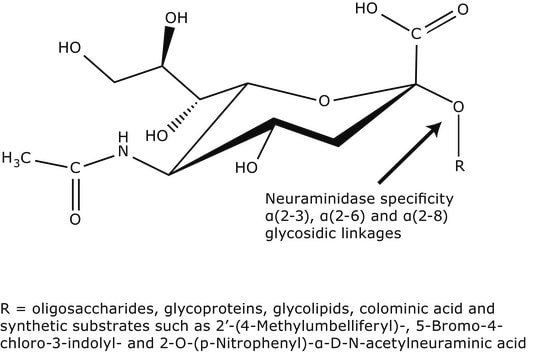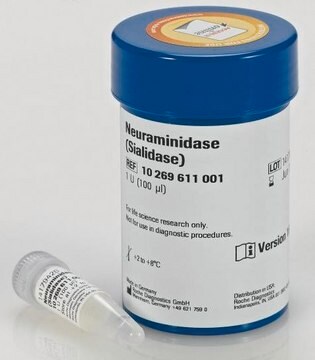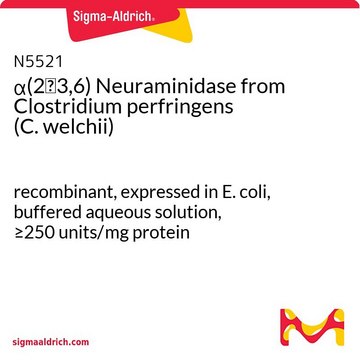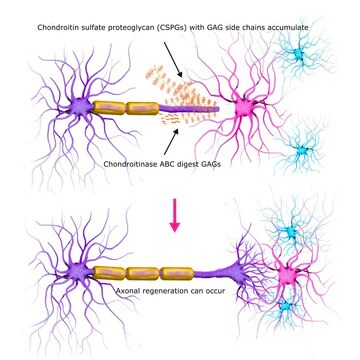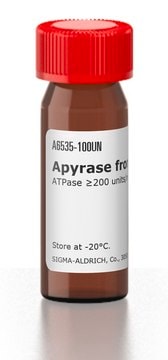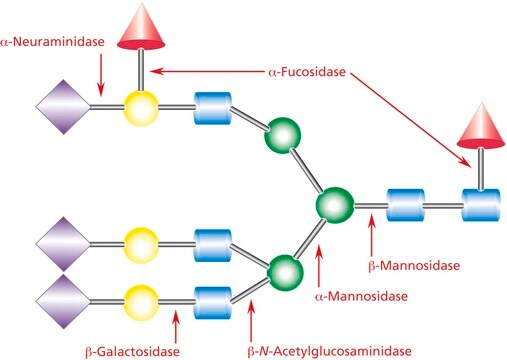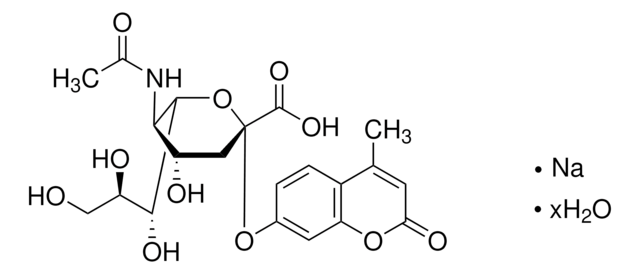Wszystkie zdjęcia(3)
Kluczowe dokumenty
N2133
Neuraminidase from Clostridium perfringens (C. welchii)
Type X, lyophilized powder, ≥50 units/mg protein (using 4MU-NANA)
Synonim(y):
Acyl-neuraminyl Hydrolase, Receptor-destroying enzyme, Sialidase
Zaloguj sięWyświetlanie cen organizacyjnych i kontraktowych
About This Item
Polecane produkty
typ
Type X
Poziom jakości
Formularz
lyophilized powder
aktywność właściwa
≥50 units/mg protein (using 4MU-NANA)
temp. przechowywania
−20°C
informacje o genach
Clostridium perfringens str. 13 ... nanI(988807)
Szukasz podobnych produktów? Odwiedź Przewodnik dotyczący porównywania produktów
Opis ogólny
Neuraminidase enzymes are glycoside hydrolase enzymes that catalyze hydrolysis of terminal sialic acid residues. The most well-known are the viral nearamidases, which promote influenza virus release.
Zastosowanie
Neuraminidase from Clostridium perfringens has been used in a study to assess purification via affinity chromatography. It has also been used in a study to investigate site-directed mutations of amino acids of the neuraminidase gene, nanH.
Działania biochem./fizjol.
Neuraminidase can block attachment of type 3 reovirus to cell membranes. This effect is related to the ability of neuraminidase to hydrolysis sialic acid residues within cell surface receptors.
Neuraminidase cleavage of sialic acid groups has been used to study recognition by antibodies of glycoprotein structures. The use of neuraminidase in the estimation of N-acetylneuraminic acid was compared favorably to two other methods.
Neuraminidases are used to cleave terminal N-acetyl neuraminic acid (sialic acid) from a variety of glycoproteins. The enzyme from Clostridium perfringens cleaves terminal sialic acid residues which are α-2,3- α-2,6- or α-2,8-linked to Gal, GlcNac, GalNAc, AcNeu, GlcNeu, oligosaccharides, glycolipids or glycoproteins. The relative rate of cleavage decreases in the order: α-2-3 > α-2-6 . α-2-8. Neuraminidase from C. perfringens cleaves α-2-3 linked sialic acid residues most efficiently, compared to A. ureafaciens, (Sigma N3642) which preferentially cleaves α-2-6 linked residues.
The use of neuraminidase to remove sialic acid residues from glycoproteins on cell surfaces has been frequently reported. Generally, procedures have indicated using neuraminidase in PBS at 37°C for 30 minutes, followed by several washings with PBS. Treatment of tissue sections with neuraminidase at much lower concentrations require longer incubation: for 1-4 U/mL in 0.1 M acetate buffer pH 4.2-5, from 2 to 20 hours at 37 °C.
Definicja jednostki
One unit will hydrolyze 1.0 micromole of 2′-(4-Methylumbelliferyl)-alpha-D-N-actetylneuraminic acid per min at pH 5.0 at 37 °C.
Uwaga dotycząca przygotowania
Purified by affinity chromatography from Type VIII (N 5631)
Komentarz do analizy
Package sizes based on 4MU-NANA units
Package sizes based on the 4MU-NANA units
Ta strona może zawierać tekst przetłumaczony maszynowo.
Hasło ostrzegawcze
Danger
Zwroty wskazujące rodzaj zagrożenia
Zwroty wskazujące środki ostrożności
Klasyfikacja zagrożeń
Resp. Sens. 1
Kod klasy składowania
11 - Combustible Solids
Klasa zagrożenia wodnego (WGK)
WGK 1
Temperatura zapłonu (°F)
Not applicable
Temperatura zapłonu (°C)
Not applicable
Środki ochrony indywidualnej
Eyeshields, Gloves, type N95 (US)
Wybierz jedną z najnowszych wersji:
Masz już ten produkt?
Dokumenty związane z niedawno zakupionymi produktami zostały zamieszczone w Bibliotece dokumentów.
Klienci oglądali również te produkty
Purification of neuraminidases from Vibrio Cholerae, Clostridium Perfringens and influenza virus by affinity chromatography.
P Cuatrecasas et al.
Biochemical and biophysical research communications, 44(1), 178-184 (1971-07-02)
J Shemer et al.
Diabetologia, 29(5), 321-329 (1986-05-01)
Specific insulin receptors are present in the liver and brain of the lizard Anolis carolinesis. In this study, the specific binding of 125I-insulin to the receptors showed time, temperature and pH dependency. Specific binding to crude membranes prepared from brain
L V Gubareva et al.
Lancet (London, England), 355(9206), 827-835 (2000-03-11)
Neuraminidase promotes influenza virus release from infected cells and facilitates virus spread within the respiratory tract. Several potent and specific inhibitors of this enzyme have been developed, and two (zanamivir and oseltamivir) have been approved for human use. Unlike amantadine
C H Chien et al.
Enzyme and microbial technology, 19(4), 267-276 (1996-09-01)
The small nanH gene encoding the neuraminidase from Clostridium perfringens ATCC 10543 was cloned in JM109 using pUC19 as a vector. Sequence analysis revealed an ORF encoding 382 amino acids without a signal peptide sequence. Four regions of amino-acid sequence
Marjorie E Kanof
Current protocols in immunology, Chapter 7, 7-7 (2008-04-25)
This unit describes a procedure for separating T cells from other mononuclear cells by exploiting the unique ability of cells to bind to and form rosettes with sheep red blood cells (SRBC). This isolation method also allows recovery of the
Protokoły
Nasz zespół naukowców ma doświadczenie we wszystkich obszarach badań, w tym w naukach przyrodniczych, materiałoznawstwie, syntezie chemicznej, chromatografii, analityce i wielu innych dziedzinach.
Skontaktuj się z zespołem ds. pomocy technicznej